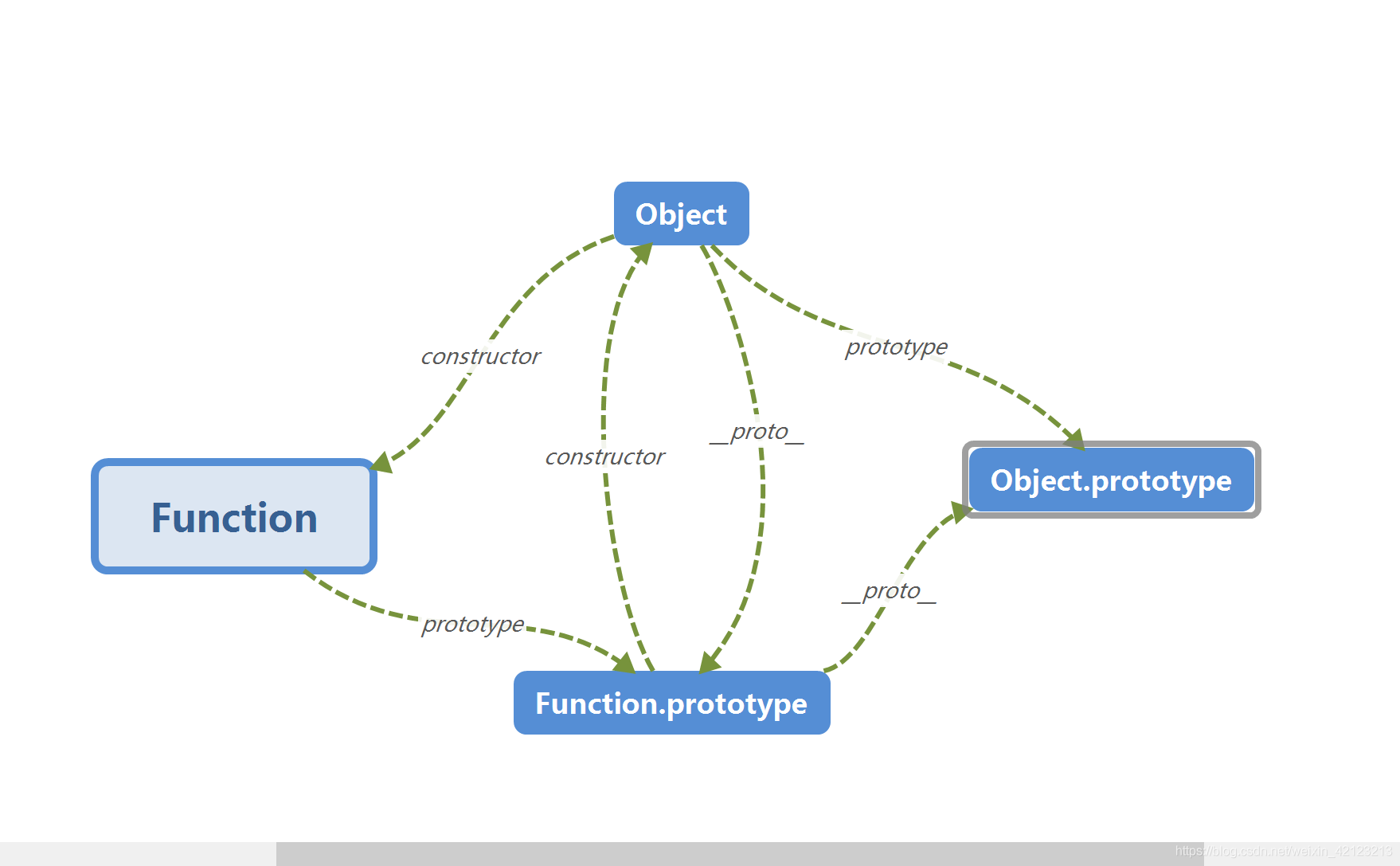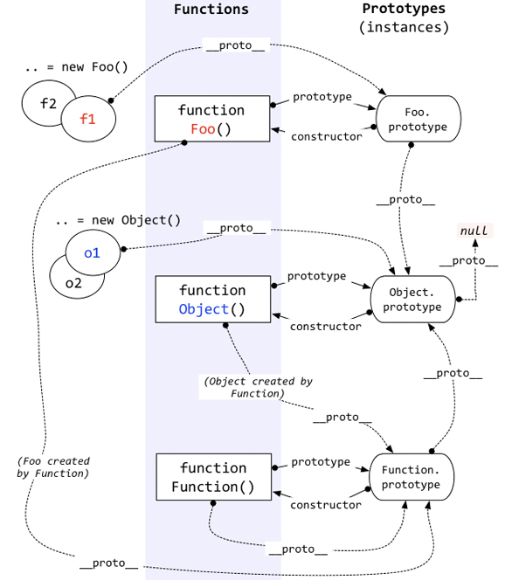es6笔记
es6…
javascript 变量
es 变量数据类型值简单分类
基本类型值–基本类型值在内存中占据固定大小的空间,因此保存在栈内存(Undefined,Null,Boolean,Number,String)
引用类型值–引用类型值保存在堆内存,变量中保存的实际上是一个指针,这个指针指向内存中的另一个位置,该位置保存对象
因此如果想要给一个变量赋值一个引用类型的值,那么则必须在堆内存中为这个值分配空间,由于这种值的大小不固定,因此不能把她保存到栈内存中,但是内存地址的大小是固定的,因此可以将内存地址保存在栈内存中。这样,在查询引用类型的变量时,就可以首先从栈中读取内存地址,在找到在堆内存中保存的值。这种访问方式叫做引用访问,因为我们不是操作的实际的值,而是被那个值引用的对象。
复制变量值
- 从一个变量向另一个变量复制基本类型的值,会在栈中创建一个新值,然后把该值复制到为新变量分配的位置上
- 当一个变量向另一个变量复制引用类型的值时,同样也会将存储在栈中的值复制一份放到为新变量分配的空间中。不同的是,这个值的副本实际上是一个指针,而这个指针指向存储在堆中的一个对象。复制操作结束后,两个变量实际上是引用的同一个对象。因此改变其中一个另外一个也会改变。
传递参数
在向参数传递基本类型的值时,被传递的值会被复制给一个局部变量(即命名参数,或者就是 arguments 对象中的一个元素),在向参数传递引用类型的值时,会把这个值在内存中的地址复制给一个局部变量,因此这个局部变量的变化会反映在函数的外部。
字符串变量
${}中可以放入任意的 JavaScript 表达式,可以进行运算,以及引用对象属性。
1 | const name = "小明"; |
函数
万物皆对象。方法(Function)是对象,方法的原型(Function.prototype)是对象,Object.prototype 的__proto__属性指向 null。
1 | Function.prototype.__proto__ === Object.prototype; |
Function 与 Object 的原型链关系
1 | //构造函数模式 |
箭头函数和普通函数
箭头函数不会创建自己的this, 所以它没有自己的this,它只会在自己作用域的上一层继承this。所以箭头函数中this的指向在它在定义时已经确定了,之后不会改变。
所有函数在执行时,会创建一个函数执行上下文,普通函数的执行上下文中会有一个变量 this,而箭头函数没有。
箭头函数中如果出现了 this ,它会永远去拿定义时、作用域链上、最近的那个 this
因为箭头函数没有自己的 this 变量,我们就没有办法修改 this 的指向,所以也不可以将其作为构造函数、它也没有 prototype 对象。
箭头函数没有 arguments 对象
是在所有普通函数中都可用的一个局部变量。 代表函数调用时传递的参数,arguments 对象不是一个数组,是一个类数组。它除了length 属性和索引之外,没有任何数组属性,比如 slice 等方法。
所以通常会使用使用
Array.prototype.slice.call(arguments)
[].slice.call(arguments)
[…arguments] 的方式,将它转换成一个数组
class 类(构造函数)
- 通过 class 关键字,可以定义类
1 | //定义类 |
- 构造函数的 prototype 属性,在 ES6 的“类”上面继续存在。事实上,类的所有方法都定义在类的 prototype 属性上面。
1 | class Point { |
- 类的内部所有定义的方法,都是不可枚举的(non-enumerable)。
- JavaScript 对象的属性可分为可枚举和不可枚举,它是由属性的 enumeration 值决定的,true 为可枚举,false 为不可枚举
- js 中原型属性一般是不可枚举的,而自己定义的属性一般是可枚举的
- 可以通过 propertyIsEnumerable()方法判断该属性是否可枚举
- 属性的枚举性影响的函数
- for…in //遍历原型与实例上的所有可枚举属性
- Object.keys(); //只能返回对象本身具有的可枚举属性。
- JSON.stringify(); //只能读取对象本身的可枚举属性,并序列化为 JSON 对象。
- Object.getOwnPropertyNames() //遍历自身所有属性(不论是否是可枚举的),不包括原型链上面的.
- Object.assign() es6 新增 //自身的可枚举属性。
1 | var person = { |
Class 不存在变量提升
类的属性名,可以采用表达式。
1 | let methodName = "getArea"; |
constructor 方法是类的默认方法,通过 new 命令生成对象实例时,自动调用该方法。一个类必须有 constructor 方法,如果没有显式定义,一个空的 constructor 方法会被默认添加。constructor 方法默认返回实例对象(即 this),完全可以指定返回另外一个对象。
可以通过实例的 __proto__属性为 Class 添加方法,使用实例的 __proto__属性改写原型,必须相当谨慎,不推荐使用,因为这会改变 Class 的原始定义,影响到所有实例。
多态实现的一个例子
1 | class Animal { |
1 | var p1 = new Point(2, 3); |
- 原型链继承和构造函数继承
- 构造函数继承的问题:构造函数外在原型上定义方法,不能重用,原型链继承可以
- 原型链继承的问题:原型中包含的引用值会在所有实例间共享。构造函数继承可以
- class 继承没有上面两个问题
1 | function SuperType() {} |
扩展运算符
- 不定参数长度
- es5 实现不定参数
1 | //在以往,我们给函数传不确定参数数量时,是通过arguments来获取的 |
- es6 实现
1 | // 接下来我们用扩展运算符看看 |
- 连接数组和对象
1 | let arr1 = [1, 2, 3]; |
- 复制和合并对象,对象重复以后面的为主,相当于重写(属于修改原对象类型的 function)
1 | var obj = { a: 1 }; |
prototype
prototype 说明
prototype 是函数的一个属性,并且是函数的原型对象。引用它的必然是函数
而__proto__是对象具有的一个属性,可称为隐式原型,一个对象的隐式原型指向构造该对象的构造函数的原型,这也保证了实例能够访问在构造函数原型中定义的属性和方法。
Array.prototype 是一个数组
String.prototype 是一个字符串
Object.prototype 是一个对象
prototype 的应用
- 原形对象增加公有属性
- 原形对象增加公有函数
- 实现原形继承
1 | // slice() 方法返回一个新的数组对象, |
__proto__ 和 prototype
__proto__和 prototype 的区别
__proto__(隐式原型)与 prototype(显式原型)prototype 和__proto__之间的唯一区别就在于前者是构造函数的属性,而后者是对象的属性。
__proto__是任何对象的属性,指向该对象的构造函数的原型对象,而 prototype 是构造函数的属性指向属于该构造函数的原型对象
__proto__指向的是当前对象的原型对象,而 prototype 指向的,是以当前函数作为构造函数构造出来的对象的原型对象。
关于 prototype 与__proto__容易让人疑惑的点是,构造函数也有__proto__属性。之所以会这样,是因为构造函数也是一个对象,它是构造函数 Function()的实例对象。因此,所有构造函数的__proto__属性都指向 Function 构造函数的原型对象。同时,原型对象是特殊的对象,每个构造函数的原型对象都会有一个__proto__属性,共同指向构造函数 Object()的原型对象。构造函数 Object()的原型对象,作为除自身以外被所有原型对象指向的对象,其担当着根节点的角色,它的__proto__属性指向 null。
隐式原型指向创建这个对象的函数(constructor)的 prototype
图例分析构造函数 Foo()构造函数的原型属性 Foo.prototype 指向了原型对象,在原型对象里有共有的方法,所有构造函数声明的实例(这里是 f1,f2)都可以共享这个方法。
原型对象 Foo.prototypeFoo.prototype 保存着实例共享的方法,有一个指针 constructor 指回构造函数。
实例 f1 和 f2 是 Foo 这个对象的两个实例,这两个对象也有属性__proto__,指向构造函数的原型对象,这样子就可以像上面 1 所说的访问原型对象的所有方法啦。另外:构造函数 Foo()除了是方法,也是对象啊,它也有__proto__属性,指向谁呢?指向它的构造函数的原型对象呗。函数的构造函数不就是 Function 嘛,因此这里的__proto__指向了 Function.prototype。其实除了 Foo(),Function(), Object()也是一样的道理。原型对象也是对象啊,它的__proto__属性,又指向谁呢?同理,指向它的构造函数的原型对象呗。这里是 Object.prototype.最后,Object.prototype 的__proto__属性指向 null。
总结:
- 对象有属性__proto__,指向该对象的构造函数的原型对象。
- 方法除了有属性__proto__,还有属性 prototype,prototype 指向该方法的原型对象。
- 箭头函数不是构造函数,没有 prototype
1 | const Arrow = (fruit) => (fruit = "apple"); // 箭头函数没有prototype |
原型链
每个对象都有原型,当访问这个变量的时候,这个变量不存在就访问他的原型,就这样一直循环下去就产生了原型链!
__proto__.__proto__.__proto__——>null (Object)
Function 分类
Function 分为两种,,普通函数和构造函数
function xxx 语法可以看成 new Function 的等价形式。
用户自定义的函数通常既可以作为普通函数使用,又可以作为构造函数来制造对象。ES6 新增的 class 语法定义的函数只能作为构造函数,ES6 新增的=>语法定义的箭头函数只能作为普通函数。
bind,apply,call
bind() 方法创建一个新的函数,在 bind() 被调用时,这个新函数的 this 被指定为 bind() 的第一个参数,而其余参数将作为新函数的参数,供调用时使用。
1 | const module = { |
偏函数
1 | function list() { |
apply() 方法调用一个具有给定 this 值的函数,以及以一个数组(或一个类数组对象)的形式提供的参数。
1 | const numbers = [5, 6, 2, 3, 7]; |
call()
该方法的语法和作用与 apply() 方法类似,只有一个区别,就是 call() 方法接受的是一个参数列表,而 apply() 方法接受的是一个包含多个参数的数组。
call()允许为不同的对象分配和调用属于一个对象的函数/方法。
call()提供新的 this 值给当前调用的函数/方法。
你可以使用 call 来实现继承:写一个方法,然后让另外一个新的对象来继承它(而不是在新对象中再写一次这个方法)。
使用 call 方法防止调用对象的原型方法被改变
1 | function Product(name, price) { |
Set 和 WeakSet,Map 和 WeakMap
- set 存储值的不重复特性
对于原始数据类型(boolean,number,string,null,undefined)如果存储相同值则只会保存一个,对于引用类型做“==”判断即引用地址完全相同则只会存一个
鉴于 set 存储值的不重复特性,经常被用来求数组去重,交集,并集,差集等操作
1 | //set求并集 |
- Map
- Map 对象保存键值对。任何值(对象或者原始值) 都可以作为一个键或一个值。
- Map 中的键值是有序的
- Object 都有自己的原型,原型链上的键名有可能和你自己在对象上的设置的键名产生冲突,而 map 健不可重复,如果键名冲突则会覆盖对应的值。
- WeakSet
- WeakSet 和 Set 结构类似,也是不重复的值的集合,但 WeakSet 的成员只能是对象。
- WeakSet 的 API:add() //增 ;delete() //删; has() //是否存在
- 注意:ws 没有 size 属性,不可遍历。因为 WeakSet 的成员都是弱引用,随时可能消失,成员是不稳定的。
- 用途:使用 ws 储存 DOM 节点,就不用担心节点从文档移除时,会引发内存泄漏
4.
- WeakMap 对象是一组键值对的集合,其中的键是弱引用对象,而值可以是任意。
- WeakMap 弱引用的只是键名,而不是键值。键值依然是正常引用。
- WeakMap 中,每个键对自己所引用对象的引用都是弱引用,在没有其他引用和该键引用同一对象,这个对象将会被垃圾回收(相应的 key 则变成无效的),所以,WeakMap 的 key 是不可枚举的。
javascript 数组常见原型方法
JavaScript 中的数组是一个相当泛用性的数据结构,能当数组,元组,队列,栈进行操作,更好的是 JavaScript 提供了很多原生的高阶函数,便于我们对数组整体操作。
Array 构建
1 | const a = new Array(10).filled(null).map((_, index) => index); |
Array.prototype.slice
slice() 方法返回一个新的数组对象,这一对象是一个由 begin 和 end 决定的原数组的浅拷贝(包括 begin,不包括 end)。原始数组不会被改变
记住记住,slice 经常用到
1 | // arguments转数组 |
Array.at()
1 | const array1 = [5, 12, 8, 130, 44]; |
Array.indexOf&Array.includes
Array.indexOf 返回的是位置的 index,Array.includes 返回 boolean
1 | const characters = [0, 1, 2, 3]; |
Array.from(new Set(new Array()))
数组去重并转为可做遍历操作的数组对象
Array.forEach()
- 包含异步操作时,await 和 async 无效,可改用 for(item of items){}实现
- 无法用 break 或者 return 中断循环
- 解决 tips:
- some():当内部 return true 时跳出整个循环
- every():当内部 return false 时跳出整个循环
1 | const a = ["a", "b", "c"]; |
Array.some()&Array.filter()&Array.find()
数组是否含有某元素,,数组含有该元素的唯一记录,,数组含有该元素的记录
1 | const character = [ |
Array.map()
- map():返回一个新的 Array,每个元素为调用 func 的结果。新数组的长度和原来的是一样的,他只不过是逐一对原来数据里的每个元素进行操作。
- filter():返回一个符合 func 条件的元素数组。筛选条件,把数组符合条件的放在新的数组里面返回。新数组和原来的数组长度不一定一样。
- some():返回一个 boolean,判断是否有元素是否符合 func 条件。数组里面所有的元素有一个符合条件就返回 true。
- every():返回一个 boolean,判断每个元素是否符合 func 条件。数组里面所有的元素都符合才返回 true。
- forEach():没有返回值,只是针对每个元素调用 func 。循环数组。和 for 的用法一样的。
1 | newArray = Array.map((value) => { |
Array.flat()
var newArray = arr.flat([depth]);
指定巢狀陣列展開的深度。預設為 1
1 | var arr1 = [1, 2, [3, 4]]; |
Array.reduce()
reduce() 方法接收一个函数作为累加器(accumulator),数组中的每个值(从左到右)开始合并,最终为一个值
- 语法
array.reduce(function(total, currentValue, currentIndex, arr), initialValue)
如果没有提供 initialValue,reduce 会从索引 1 的地方开始执行 callback 方法,跳过第一个索引。如果提供 initialValue,从索引 0 开始。
- 用法
- 计算数组中每个元素出现的次数
1 | var sum = arr.reduce((x, y) => x + y); |
- 数组去重
1 | let arr = [1, 2, 3, 4, 4, 1]; |
- 将二维数组转化为一维
1 | let arr = [ |
- 将多维数组转化为一维
1 | let arr = [ |
- 对象属性求和
1 | var result = [ |
参数:
- callback(执行数组中每个值的函数,包含四个参数)
- previousValue
上一次调用回调返回的值,或者是提供的初始值(initialValue) - currentValue
数组中当前被处理的元素 - index
当前元素在数组中的索引 - array
调用 reduce 的数组 - initialValue
作为第一次调用 callback 的第一个参数。
1 | var total = [0, 1, 2, 3, 4].reduce(function ( |
1 | var flattened = [ |
当然最好还是去 mdn 看看具体用法组好
循环 tips
因为 js 中对数据的遍历除了 for 循环还有 forEach、map、filter、some 等,除了 for 循环外(for,for…of),其他的遍历都是对键值的遍历,也就是除了存在的元素外的 undefined 不会对不存在的值执行回调.,所以也就不会造成性能损耗
1 |
js 同步异步
promise
new Promise(executor)
1 | // executor 的函数签名为 |
Promise.then 方法返回一个新的 promise 实例,这是实现链式调用的根本
- 基础用用
promise 状态:
- pending 初始状态,既没有被兑现,也没有被拒绝
- fulfilled 意味着操作成功完成
- rejected 意味着操作失败
1 | new promise((resolve, reject) => { |
.then() 方法需要两个参数,第一个参数作为处理已兑现状态的回调函数,而第二个参数则作为处理已拒绝状态的回调函数。每一个 .then() 方法还会返回一个新生成的 promise 对象,这个对象可被用作链式调用
.catch() 其实只是没有给处理已兑现状态的回调函数预留参数位置的 .then() 而已
1 | myPromise |
- 静态方法
- Promise.all(iterable) 等到所有的 promise 对象都成功或有任意一个 promise 失败
- Promise.allSettled(iterable) 返回一个 promise,该 promise 在所有 promise 都敲定后完成,并兑现一个对象数组,其中的对象对应每个 promise 的结果
- Promise.any(iterable) 接收一个 promise 对象的集合,当其中的任意一个 promise 成功,就返回那个成功的 promise 的值。
- Promise.race(iterable) 当 iterable 参数里的任意一个子 promise 成功或失败后,父 promise 马上也会用子 promise 的成功返回值或失败详情作为参数调用父 promise 绑定的相应处理函数,并返回该 promise 对象。
- Promise.all() 方法是 && 的关系;Promise.any() 方法是 || 的关系; Promise.race()方法是 赛跑机制
await 和 async
在 forEach 中存在异步操作时用 await 和 async 时有问题,改用 for(item of items)实现
generator&yield
function* 这种声明方式(function 关键字后跟一个星号)会定义一个生成器函数 (generator function),它返回一个 Generator 对象。
es6 关于 yield 和 next 的用法
接收参数
1
2
3
4
5
6
7
8function* idMaker() {
var index = arguments[0] || 0;
while (true) yield index++;
}
var gen = idMaker(5);
console.log(gen.next().value); // 5
console.log(gen.next().value); // 6yield* 示例
1
2
3
4
5
6
7
8
9
10
11
12
13
14
15
16
17
18
19function* anotherGenerator(i) {
yield i + 1;
yield i + 2;
yield i + 3;
}
function* generator(i) {
yield i;
yield* anotherGenerator(i); // 移交执行权
yield i + 10;
}
var gen = generator(10);
console.log(gen.next().value); // 10
console.log(gen.next().value); // 11
console.log(gen.next().value); // 12
console.log(gen.next().value); // 13
console.log(gen.next().value); // 20generator 函数中有 return
当在生成器函数中显式 return 时,会导致生成器立即变为完成状态,即调用 next() 方法返回的对象的 done 为 true。
如果 return 后面跟了一个值,那么这个值会作为当前调用 next() 方法返回的 value 值。再调用 next()就不执行了使用迭代器遍历二维数组并赋给一维数组
1
2
3
4
5
6
7
8
9
10
11
12
13
14
15
16
17
18
19
20
21
22function* iterArr(arr) {
//迭代器返回一个迭代器对象
if (Array.isArray(arr)) {
// 内节点
for (let i = 0; i < arr.length; i++) {
yield* iterArr(arr[i]); // (*)递归
}
} else {
// 离开
yield arr;
}
}
// 使用 for-of 遍历:
var arr = ["a", ["b", "c"], ["d", "e"]];
for (var x of iterArr(arr)) {
console.log(x); // a b c d e
}
// 或者直接将迭代器展开:
var arr = ["a", ["b", ["c", ["d", "e"]]]];
var gen = iterArr(arr);
arr = [...gen];
generator && async 和 await
ES2017 标准引入了 async 函数,在异步处理上,async 函数就是 Generator 函数的语法糖。
顺序执行和异步执行
1 | //顺序执行 |
例子:给定一个 URL 数组,如何实现接口的继发和并发?
1 | // 继发一 |
async 错误捕获
1 | //写法1 |
Symbol
本质上是一种唯一标识符,可用作对象的唯一属性名
使用 symbol 在对象上创建私有属性
设置作为对象的 key 的时候,遍历也不可见,只有 Reflect.ownKeys()时才能看到,
配合 json
做对象注入的时候不可见
1 | const person = { |
Symbol 应用场景
- 对象有些 key-value 不想被枚举出来
可以用 Symbol 来当做对象的属性名,作为属性的属性不会被枚举出来,这也是 JSON.stringfy(obj)时,Symbol 属性会被排除在外的原因
1 | // 遍历不出来 |
- 使用 Symbol 定义类的私有属性
以下例子,PASSWORD 属性无法在实例里获取到
1 | class Login { |
symbol.Iterator
Symbol.iterator 为每一个对象定义了默认的迭代器。该迭代器可以被 for…of 循环使用。
内置类型拥有默认的迭代器行为
Array,Set,Map,TypeArray,String,arguments
for…of 语句在可迭代对象(包括 Array,Map,Set,String,TypedArray,arguments 对象等等)上创建一个迭代循环,调用自定义迭代钩子,并为每个不同属性的值执行语句
代替 for…of 手动控制迭代
1 | const arr = ["a", "b", "c", "d", "e"]; |
1 | function logIterable(it) { |
Reflect 与 Proxy 与 Object
Proxy 区别于 Object.definedProperty
- Object.defineProperty 方法会直接在一个对象上定义一个新属性,或者修改一个对象的现有属性,并返回此对象。
- Object.defineProperty 只能监听到属性的读写,而 Proxy 除读写外还可以监听属性的删除,方法的调用等。
1 | const list = [1, 2, 3]; |
数组的 Object.definedProperty
reflect 说明
Reflect 是一个内置的对象,它提供拦截 JavaScript 操作的方法。这些方法与 proxy handlers 的方法相同
判断一个 obj 有定义或者继承了属性 name: name in obj = Reflect.has(obj,name)
删除一个属性 :delete obj[name] = Reflect.deleteProperty(obj,name)
- Reflect 的所有属性和方法都是静态的(就像 Math 对象)
- Reflect 是 ES6 为了操作对象而新增的 API,其中的一些方法与 Object 相同, 尽管二者之间存在 某些细微上的差别
- 代理实现,在目标对象之前架设一层拦截,外部所有的访问都必须先通过这层拦截,因此提供了一种机制,可以对外部的访问进行过滤和修改。
1 | let proxy = new Proxy(target, handler); // target是表示所要拦截的对象,handle是用来定制拦截行为的对象 |
Object.defineProperty
能劫持变量,实现数据双向绑定
1 | // 如何让(a===1&&a===2&&a===3)的值为true |
实现观察者模式
1 | // 定义 Set 集合 |

